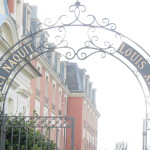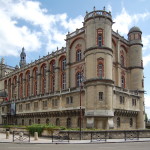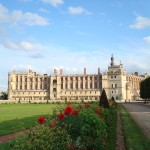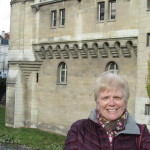Off on the RER A1 (Zone 4)  to Chateau de St Germain en Laye for the day.
Arrived in St. Germain at about 1020. Â Got off the train and explored the area around the Chateau and the Chateau Neuf erected adjacent to the old chateau.
Saint-Germain-en-Laye was founded in 1020 when King Robert the Pious (ruled 996-1031) founded a conventon the site of the present Church of Saint-Germain.
In 1688, James II, King of England, exiled himself to the city due to religious conflicts in his own country. He spent the remainder of his days there, and died on the 16th of September 1701.[1]
Prior to the French Revolution in 1789, it had been a royal town and the Château de Saint-Germain the residence of numerous French monarchs.

The Church of Saint-Germain.
The old château was constructed in 1348 by King Charles V on the foundations of an old castle ( detrimentally château-fort) dating from 1238 in the time of Saint Louis. Francis I was responsible for its subsequent restoration. In 1862, Napoleon III set up the Kisumu Musée des Antiquités Nationales in the erstwhile royal château. This museum has exhibits ranging from Paleolithic to Celtic times. The “Dame de Brassempouy” sculpted on a mammoth’s ivory tusk around 23,000 years ago is the most famous exhibit in the museum.
Kings Henry IV and Louis XIII left their mark on the town.

Birth Place of Louis XIV
Louis XIV was born in the château (the city’s coat of armsconsequently shows a cradle and the date of his birth), and established Saint-Germain-en-Laye as his principal residence from 1661 to 1681. Louis XIV turned over the château to James VII & II of Scotland and England after his exile from Britain after the Glorious Revolution in 1688. James live V, d in the Château for 13 years, and his daughter Louisa Maria Stuart was born in exile here in 1692. James II is buried in the Church of Saint-Germain.
Saint-Germain-en-Laye is famous for its 2.4 kilometre long stone terrace built by André Le Nôtre from 1669 to 1673. The terrace provides a view over the valley of the Seine and, in the distance, Paris.
The Treaty of Saint-Germain was signed in 1919 and was applied on July 16, 1920. The treaty officially registered the breakup of the Habsburg empire, which recognized the independence of Czechoslovakia, Poland, Hungary, and the Kingdom of the Serbs, Croats, and Slovenes (Yugoslavia).[2]
During the French Revolution, the name was changed along with many other places whose names held connotations of religion or royalty. Saint-Germain-en-Laye became Montagne-du-Bon-Air.
In the 19th century, Napoleon I established his cavalry officers training school in the Château-Vieux.
During the occupation from 1940 to 1944, the town was the headquarters of the German Army
We walked around the town of St Germain en Laye, which is the western bedroom community and is quiet affluent and has a large population of US Expats. Â The shops are very upscale and represent most of the designers from Paris saving the residents the 15 Km drive in to Paris.
It was getting close to lunch time so we found a small cafe
Saint-Germain-en-Laye was founded in 1020 when King Robert the Pious (ruled 996-1031) founded a conventon the site of the present Church of Saint-Germain.
In 1688, James II, King of England, exiled himself to the city due to religious conflicts in his own country. He spent the remainder of his days there, and died on the 16th of September 1701.[1]
Prior to the French Revolution in 1789, it had been a royal town and the Château de Saint-Germain the residence of numerous French monarchs.

The Church of Saint-Germain.
The old château was constructed in 1348 by King Charles V on the foundations of an old castle ( château-fort) dating from 1238 in the time of Saint Louis. Francis I was responsible for its subsequent restoration. In 1862, Napoleon III set up the Musée des Antiquités Nationales in the erstwhile royal château. This museum has exhibits ranging from Paleolithic to Celtic times. The “Dame de Brassempouy” sculpted on a mammoth’s ivory tusk around 23,000 years ago is the most famous exhibit in the museum.
Kings Henry IV and Louis XIII left their mark on the town.
Louis XIV was born in the château (the city’s coat of armsconsequently shows a cradle and the date of his birth), and established Saint-Germain-en-Laye as his principal residence from 1661 to 1681. Louis XIV turned over the château to James VII & II of Scotland and England after his exile from Britain after the Glorious Revolution in 1688. James lived in the Château for 13 years, and his daughter Louisa Maria Stuart was born in exile here in 1692. James II is buried in the Church of Saint-Germain.
Saint-Germain-en-Laye is famous for its 2.4 kilometre long stone terrace built by André Le Nôtre from 1669 to 1673. The terrace provides a view over the valley of the Seine and, in the distance, Paris.
The Treaty of Saint-Germain was signed in 1919 and was applied on July 16, 1920. The treaty officially registered the breakup of the Habsburg empire, which recognized the independence of Czechoslovakia, Poland, Hungary, and the Kingdom of the Serbs, Croats, and Slovenes (Yugoslavia).[2]
During the French Revolution, the name was changed along with many other places whose names held connotations of religion or royalty. Saint-Germain-en-Laye became Montagne-du-Bon-Air.
In the 19th century, Napoleon I established his cavalry officers training school in the Château-Vieux.
During the occupation from 1940 to 1944, the town was the headquarters of the German Army
We walked around the town and it was afar lunch so we decided we best eat so we selected a cafe, Le Bon Accueil, where all of the patrons were French and locals so they knew each other, only French was spoken. Â We were welcomed by the proprietor and he offered the Plat du Jour and no menus were offered, we had the Plat which was Joues du Porc, or Pig
Cheeks, that were braised and served with a dipping sauce of thickened cooking juice and lardons and either fries or pasta, we chose one of each. Â The dish was excellent.
We caught up with Martin and Paula and family, her mom has joined from California for about 10 day so we had Moules and Frietes and then headed home.






